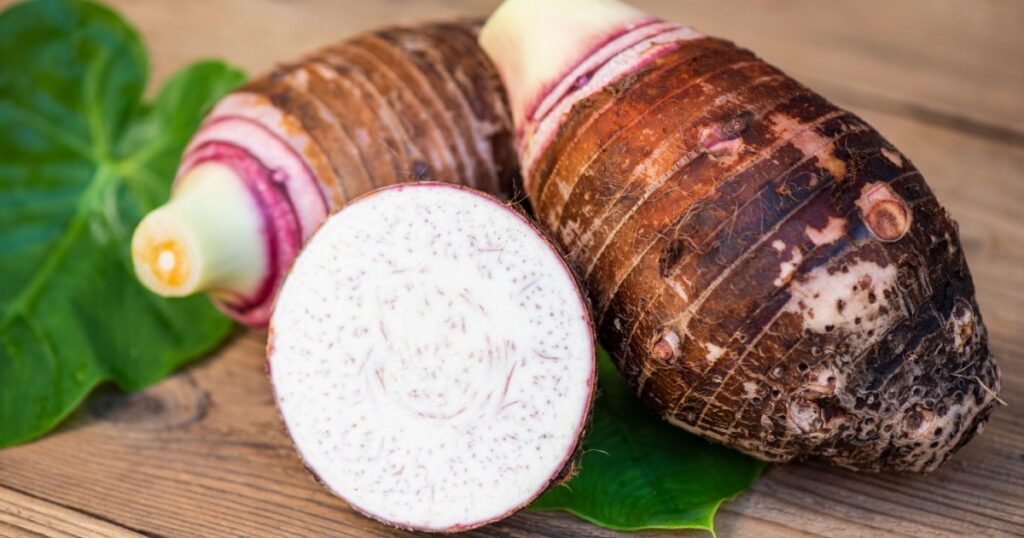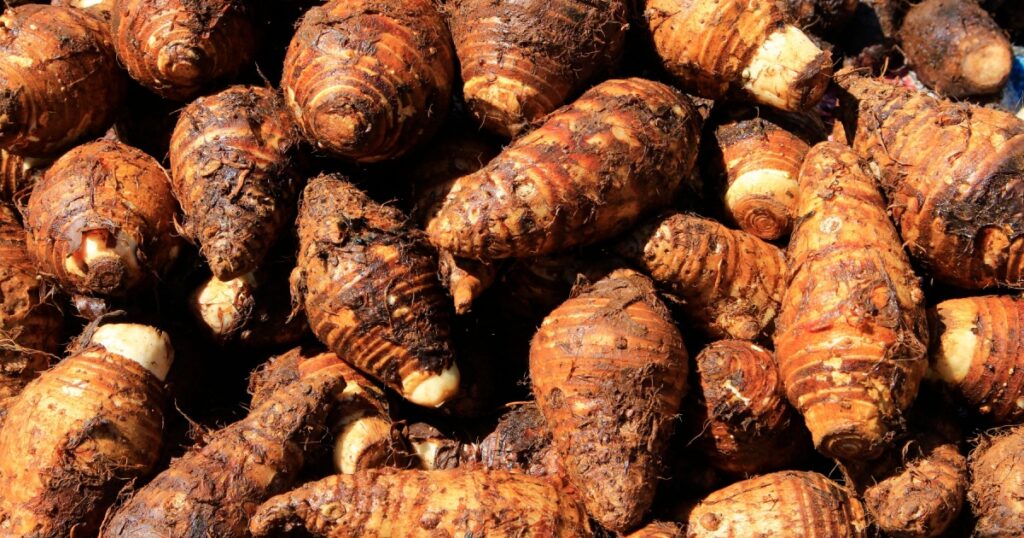In a world where people are constantly searching for ways to improve their health and well-being, it’s surprising that so many have never heard of taro root. This odd-looking root vegetable may not be a staple in most kitchens, but it is certainly worth considering due to its incredible health benefits. From boosting the immune system to improving digestion, taro root is a nutritious addition to any diet.
What is Taro Root?

Taro root, scientifically known as Colocasia esculenta, is a starchy root vegetable that belongs to the Araceae family. It is native to Southeast Asia but has gained popularity worldwide due to its unique taste and texture. Taro root is characterized by its rough, brown exterior and white or purple flesh. Although it may appear intimidating, the taste is mildly sweet, similar to that of a potato. (1)
Read More: Three amazing benefits of turmeric, the ‘golden spice’
How is it Used?

Taro root can be prepared in numerous ways and is a versatile ingredient in various dishes. It can be boiled, steamed, baked, or even fried. Once cooked, the flesh becomes soft and creamy, making it perfect for mashing or pureeing. Taro root is commonly used in soups, stews, curries, and even desserts. In some cultures, it is also used to make flour and chips. (2)
Health Benefits

This peculiar root vegetable not only is tasty, but it also comes with a host of benefits for your health. With so many incredible health-boosting properties, it’s hard to imagine how taro root isn’t already more popular than it is. These are 10 of its top health benefits.
1. Digestive Health

Taro root is an excellent source of dietary fiber and resistant starch, which aids in maintaining a healthy digestive system. The fiber content helps regulate bowel movements and prevent constipation. (3)
2. Heart Health

This root vegetable is low in fat and contains no cholesterol, making it a heart-healthy food choice. It also contains potassium, which helps lower blood pressure and reduce the risk of cardiovascular disease. (4)
3. Immune System Boost

Taro root is rich in vitamin C, an essential nutrient that boosts the immune system, protects cells from damage, and enhances the body’s ability to fight off infections. (5)
Read More: It’s Not Just in Candy: 10 Health Benefits of Licorice Root
4. Bone Health

The high calcium content in taro root promotes strong and healthy bones. It also contains magnesium, which works in conjunction with calcium to improve bone density and reduce the risk of osteoporosis. (6)
5. Weight Management

Taro root is a great addition to a weight-loss diet as it is low in calories but high in fiber. The fiber content helps keep you feeling full for longer, reducing the urge to overeat.
Read More: 4 Potential Health Benefits of Okra (Cholesterol, Blood Sugar and More)
6. Diabetes Control

Taro root has a low glycemic index, meaning it does not cause a rapid increase in blood sugar levels. This makes it a suitable food choice for individuals with diabetes or those at risk of developing the condition. (7)
7. Brain Function

Taro root contains vitamin E, which is known to promote healthy brain function. It may help prevent cognitive decline as we age and improve memory and concentration. (8)
8. Anti-inflammatory Properties

Taro root contains various antioxidants and anti-inflammatory compounds that help reduce inflammation in the body, preventing chronic diseases such as arthritis and cancer.
9. Skin Health

The vitamin E content in taro root contributes to healthy skin by preventing oxidative stress and protecting against UV damage. It also promotes collagen production, resulting in youthful-looking skin. (9)
10. Energy Booster

Taro root is an excellent source of complex carbohydrates, providing a sustained release of energy throughout the day. This makes it an ideal food choice for athletes or individuals with active lifestyles.
Read More: 7 Health Benefits of Avocado Oil
How to Incorporate Taro Root into Your Daily Diet

Adding taro root to your diet is easy and can bring a unique flavor to your meals. Remember to wash and peel taro root thoroughly before cooking, as the skin can be rough and may contain dirt or debris.
Here are a few ways to incorporate taro root into your daily routine:

- Boil, mash, and season taro root to create a creamy side dish.
- Bake thin slices of taro root to make crispy chips.
- Blend cooked taro root with coconut milk to create a delicious and nutritious soup.
- Substitute taro root for potatoes in your favorite recipes, such as stews or casseroles.
- Grate taro root and mix it into batters for pancakes or muffins, adding a nutritious twist to your breakfast options.
A Super Root Vegetable

While taro root may be unfamiliar to many, its health benefits make it worth exploring. From supporting a healthy heart to boosting the immune system, taro root offers a range of advantages. By incorporating this odd-looking root vegetable into your diet, you can improve your overall well-being and embark on a culinary adventure with its unique taste and texture. Give taro root a try and be amazed by the incredible health benefits it has to offer.
Read More: 12 Best Foods To Help Boost Collagen
Sources
- “Taro Roots: An Underexploited Root Crop.” NCBI. Md. Jannatul Ferdaus,1 Ezzine Chukwu-Munsen,1 Aline Foguel,2 and Roberta Claro da Silva. July 27, 2023.
- “How taro is eaten around the world.” National Geographic. Abigail Bassett. July 11, 2023.
- “Short Chain Fatty Acids in the Colon and Peripheral Tissues: A Focus on Butyrate, Colon Cancer, Obesity and Insulin Resistance.” NCBI. Sean M. McNabney and Tara M. Henagan. December 2017.
- “Production of resistant starch from taro (Colocasia esculenta L. Schott) corm and determination of its effects on health by in vitro methods.” Pubmed. Sebnem Simsek and Sedef Nehir El. October 15, 2012.
- “Vitamin C.” NIH
- “[HISTORICAL RECORD]: PAMANA, WHOLE PURPLE YAM.” FDC
- “Hypoglycemic Effect of Modified Water Yam Flour ( Dioscorea alata ) on Diabetic Wistar Rats ( Rattus norvegicus ).” Semantic Scholar. Rosida, Harijono, Estiasih Teti and S. Endang. January 14, 2016.
- “The Role of Vitamin E in Slowing Down Mild Cognitive Impairment: A Narrative Review.” NCBI. Ram Lakhan, Manoj Sharma, Kavita Batra,and Frazier B. Beatty. November 2021.
- “Vitamin E for Skin: What Does It Do?” Cleveland Clinic. February 23, 2022.

